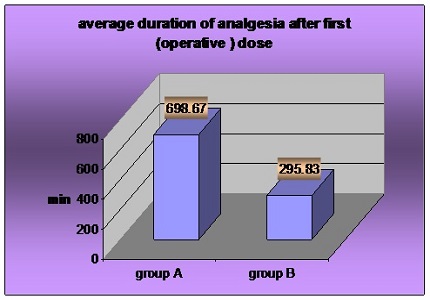Effects of buprenorphine and fentanyl in brachial plexus block on operative and post-operative analgesia: a clinical comparative study
Abstract
Introduction: Surgical pain is an acute pain and is defined as conscious perception of noxious stimuli. Peripheral neural blockade has brought a new dimension in regional anaesthesia and is now a well accepted component of comprehensive anaesthetic technique.
Aim: The study aimed to compare the quality of intra-operative analgesia and the duration of post-operative analgesia with use of buprenorphine and fentanyl administered with lignocaine with adrenaline in the brachial plexus block through the catheter technique of axillary brachial plexus blockade for upper limb surgeries.
Materials and Methods: The study included 30 patients in group A (buprenorphine) and 30 in group B (fentanyl) with ASA I and ASA II physical status of either sex, in the age group of 15 to 60 years weighing between 45 to 85 kg undergoing upper limb surgeries.
Results: The onset of analgesia in the operative and post operative doses was earlier with fentanyl than buprenorphine. The duration of analgesia in operative dose and post operative doses was more with buprenorphine. Quality of analgesia is found to be better with fentanyl.
Conclusion: patients suffer needlessly due to improper post operative analgesia. So, the results of this study can be incorporated in anesthetic technique to reduce patient’s post operative pain.
Downloads
References
2. Ang ET, Lassale B, Goldfarb G. Continuous axillary brachial plexus block--a clinical and anatomical study. Anesth Analg. 1984 Jul;63(7):680-4. [PubMed]
3. Stein C. Peripheral mechanisms of opioid analgesia. Anesth Analg. 1993 Jan;76(1):182-91. [PubMed]
4. Gormley WP, Murray JM, Fee JP, Bower S. Effect of the addition of alfentanil to lignocaine during axillary brachial plexus anaesthesia. Br J Anaesth. 1996 Jun;76(6):802-5.
5. Power I. Recent advances in postoperative pain therapy. Br J Anaesth. 2005 Jul;95(1):43-51. Epub 2004 Dec 3. [PubMed]
6. Gould D, Kelly D, Goldstone L, Gammon J. Examining the validity of pressure ulcer risk assessment scales: developing and using illustrated patient simulations to collect the data. J Clin Nurs. 2001 Sep;10(5):697-706. [PubMed]
7. Nishikawa K, Kanaya N, Nakayama M, Igarashi M, Tsunoda K, Namiki A. Fentanyl improves analgesia but prolongs the onset of axillary brachial plexus block by peripheral mechanism. Anesth Analg. 2000 Aug;91(2):384-7.
8. Viel EJ, Eledjam JJ, De La Coussaye JE, D'Athis F. Brachial plexus block with opioids for postoperative pain relief: comparison between buprenorphine and morphine. Reg Anesth. 1989 Nov-Dec;14(6):274-8.
9. Karakaya D, Büyükgöz F, Bariş S, Güldoğuş F, Tür A. Addition of fentanyl to bupivacaine prolongs anesthesia and analgesia in axillary brachial plexus block. Reg Anesth Pain Med. 2001 Sep-Oct;26(5):434-8. [PubMed]
10. Reuben SS, Reuben JP. Brachial plexus anesthesia with verapamil and/or morphine. Anesth Analg. 2000 Aug;91(2):379-83. [PubMed]
11. Gaumann D, Forster A, Griessen M, Habre W, Poinsot O, Della Santa D. Comparison between clonidine and epinephrine admixture to lidocaine in brachial plexus block. Anesth Analg. 1992 Jul;75(1):69-74.
12. Dahl J, Hahnel J, Kustermann J. Axillary blockade of the brachial plexus. A prospective study of blockade success using electric nerve stimulation. Anaesthetist 1992; 43(12):780-5.
13. Eifert B, Hähnel J, Kustermann J. [Axillary blockade of the brachial plexus. A prospective study of blockade success using electric nerve stimulation]. Anaesthesist. 1994 Dec;43(12):780-5.
14. Bazin JE, Massoni C, Bruelle P, Fenies V, Groslier D, Schoeffler P. The addition of opioids to local anaesthetics in brachial plexus block: the comparative effects of morphine, buprenorphine and sufentanil. Anaesthesia. 1997 Sep;52(9):858-62.
15. Candido KD, Franco CD, Khan MA, Winnie AP, Raja DS. Buprenorphine added to the local anesthetic for brachial plexus block to provide postoperative analgesia in outpatients. Reg Anesth Pain Med. 2001 Jul-Aug;26(4):352-6.
16. Pham-Dang C, Meunier JF, Poirier P, Kick O, Bourreli B, Touchais S, Le Corre P, Pinaud M. A new axillary approach for continuous brachial plexus block. A clinical and anatomic study. Anesth Analg. 1995 Oct;81(4):686-93.



 OAI - Open Archives Initiative
OAI - Open Archives Initiative


